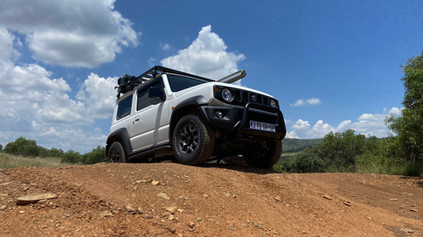Off-roading in a 4x4 vehicle can be an exhilarating and challenging experience. Whether you're a beginner or a seasoned off-roader, understanding and employing the right driving techniques is crucial to ensure a safe and enjoyable adventure. In this blog post, we will explore four essential 4x4 driving techniques that will help you navigate through various terrains with confidence and skill.
SA Adventure’s introductory 4x4 training course is a great way to get started in the world of off-roading. It is suitable for all types of 4x4 and 4x4 soft-roader vehicles and we cover the points below and a whole lot more too!
1. Proper Tyre Selection and Pressure:
Choosing the right tyres for your 4x4 vehicle is the first step in enhancing its off-road capabilities. Off-road tyres with more aggressive tread patterns, such as an all-terrain tyre, provide better traction on rough and slippery surfaces. Additionally, adjusting tyre pressure according to the terrain you're driving on is crucial. Lowering tyre pressure allows for a larger contact patch with the ground, which increases traction and improves the vehicle's ability to conquer obstacles and reduces the chances of becoming stuck.
2. Understanding 4x4 Modes and Differential Locks:
Most 4x4 vehicles offer different modes, such as 2H (two-wheel drive), 4H (four-wheel drive high range), and 4L (four-wheel drive low range). Understanding when and how to use these modes is essential. 2H is suitable for regular driving on paved roads, while 4H is ideal for off-road conditions with loose surfaces such as gravel roads. 4L provides maximum torque and is suitable for steep inclines, deep mud or sand, or rocky terrains. Differential locks allow power to be evenly distributed to left and right or front and rear wheels, providing enhanced traction when one or more wheels lose grip.
3. Approach, Departure, and Breakover Angles:
Off-road terrains often present obstacles like rocks, logs, or steep inclines. Understanding the concept of approach, departure, and break-over angles is crucial in preventing your 4x4 vehicle from getting stuck or damaged. Approach angle refers to the steepest slope a vehicle can drive onto without touching its front bumper. The departure angle is the steepest slope a vehicle can drive off without hitting its rear end. The break-over angle is the maximum slope a vehicle can handle without its undercarriage or chassis touching the ground. Knowing your vehicle's angles will help you navigate obstacles safely without getting stuck or causing damage to your vehicle.
4. Controlled Throttle and Momentum:
Maintaining controlled throttle and momentum is vital while off-roading. Applying too much throttle can cause wheel spin and loss of traction, while too little throttle can result in getting stuck or stalling. Gradual and smooth acceleration is key to maintaining traction and control. Additionally, maintaining a consistent speed and momentum can help carry you through challenging terrains like sand or mud, minimizing the risk of getting stuck.
Conclusion:
Mastering 4x4 driving techniques is a combination of knowledge, practice, and experience. By understanding tyre selection and pressure, utilizing 4x4 modes and differential lockers appropriately, considering approach, departure, and break-over angles, and maintaining controlled throttle and momentum, you'll be well-prepared to tackle various off-road challenges. Remember, safety should always be a priority, so ensure you have the necessary skills and equipment before embarking on any off-road adventure.
It's time to LEVEL UP your off-road driving skills and to help you do that, we're giving you 15% off our introductory 4x4 training course!
Book your place online today, details are at the link below... USE THE PROMO CODE "PANDA" AT CHECKOUT to claim your discount...

If you liked this post, please share it with your friends and family on your social media channels, it really helps us!... Please support local South African companies during this trying time...
Stay Safe, Big Love, the SA Adventure Team!















